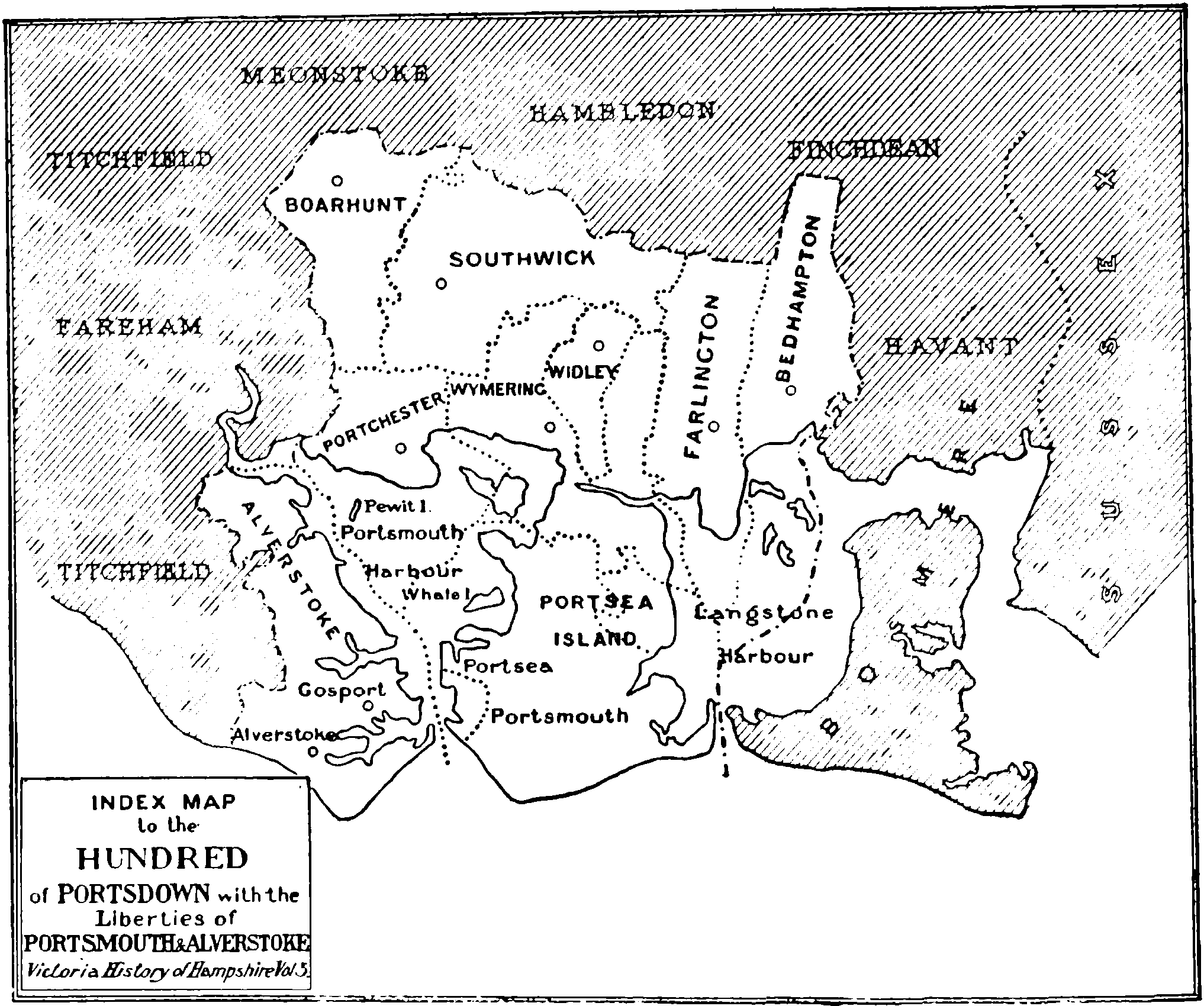A History of the County of Hampshire: Volume 3. Originally published by Victoria County History, London, 1908.
This free content was digitised by double rekeying. All rights reserved.
'The hundred of Portsdown: Introduction', in A History of the County of Hampshire: Volume 3, ed. William Page (London, 1908), British History Online https://www.british-history.ac.uk/vch/hants/vol3/pp140-141 [accessed 30 April 2025].
'The hundred of Portsdown: Introduction', in A History of the County of Hampshire: Volume 3. Edited by William Page (London, 1908), British History Online, accessed April 30, 2025, https://www.british-history.ac.uk/vch/hants/vol3/pp140-141.
"The hundred of Portsdown: Introduction". A History of the County of Hampshire: Volume 3. Ed. William Page (London, 1908), British History Online. Web. 30 April 2025. https://www.british-history.ac.uk/vch/hants/vol3/pp140-141.
THE HUNDRED OF PORTSDOWN WITH THE LIBERTIES OF PORTSMOUTH AND ALVERSTOKE
CONTAINING THE PARISHES OF
| BEDHAMPTON | WYMERING with COSHAM and HILSEA |
| BOARHUNT | WIDLEY (fn. 1) |
| FARLINGTON with DRAYTON | THE LIBERTY OF PORTSMOUTH AND PORTSEA ISLAND |
| PORTCHESTER | |
| SOUTHWICK | THE LIBERTY OF ALVERSTOKE |
At the time of the Domesday Survey the hundred of Portsdown included Bedhampton, Wymering, Cosham, Boarhunt, Portchester, Buckland, Copnor, and Fratton. It is impossible to give the total assessment in 1086, as Wymering and part of Portchester were not assessed in hides; the amount of the land assessed was 39½ hides, so the hundred probably contained about 45 hides.

INDEX MAP to the HUNDRED of PORTSDOWN with the Liberties of PORTSMOUTH & ALVERSTOKE
By the fourteenth century the hundred had undergone considerable alteration; Portchester had become a separate liberty; and Southwick, Farlington, Walesworth, Portsea, Eastney, and Milton had been added.
Portsea, Eastney, and Milton, with Buckland, Copnor, and Fratton, comprised practically the whole of modern Portsmouth, which was therefore in all probability included in Portsdown.
The part of Portsea called Portsea gildable was still included in Portsdown Hundred in 1637, for in that year the inhabitants of Portsea, under the command of the governor of Portsmouth, petitioned against the commands of the constables of Portsdown Hundred; but the suit terminated in favour of the constables. (fn. 2)
A small portion of Brockhampton parish was originally part of the parish of Bedhampton, and consequently formed part of this hundred; the remainder being in Havant parish and Bosmere Hundred. (fn. 3)
Walesworth must have been included in Portsdown Hundred by the reign of Edward I, for in this reign the abbot of Titchfield was forced to allow the villeins of Walesworth to pay suit 'at the hundred of the lord king at Portsdown.' (fn. 4)
Owing evidently to the small extent of Bosmere Hundred, which is so often mentioned with that of Portsdown, the sheriff held only one tourn for the two hundreds. Thus in 1465 the tithing men of Farlington made presentment at the sheriff's tourn for the two hundreds at Grenefeld, at which place the sheriff's tourn seems usually to have been held. (fn. 5) On the other hand the sheriff's returns were sometimes made separately for the two hundreds (fn. 6); and it is remarkable that the profits of Bosmere Hundred at this time were 59s. 8d. and those of Portsdown, which was a far larger hundred, were only 30s. 3d. (fn. 7)
In 1549 a levy of a tenth produced £74 9s. from the hundreds of Bosmere and Portsdown. (fn. 8) A similar tax in 1570 produced £123 19s. 8d. from the two hundreds. (fn. 9)
By 1605 there was a change in the arrangement of the hundred; Portchester, which in 1316 had been a liberty by itself, was included, though it was still assessed separately; Portsmouth, on the other hand, which had formerly been included in the general assessment, was rated separately. (fn. 10)
Probably about this time, though the exact date is not certain, Walesworth was removed from Portsdown Hundred and included in that of Finchdean. In 1835 the borough boundaries of Portsmouth include Portsea. (fn. 11) The hundred of Portsdown therefore assumed its modern proportions, consisting of seven parishes with numerous tithings, the most important of which are Waterloo, Drayton, Hilsea and Cosham.
The hundred of Portsdown has always been in the hands of the king. In an inquisition taken in 1267 the jurors said that it would be no damage to the king if he farmed the hundred of Portsdown. (fn. 12) In 1160 40s. was returned for a murder fine, (fn. 13) and in 1168 20s. for false judgement. (fn. 14) The liberty of Portchester in 1316 was also 'of the lord king but in the hands of Margaret the Queen.' (fn. 15)